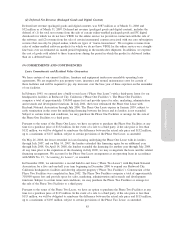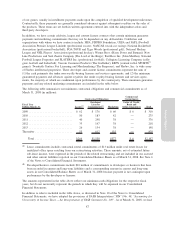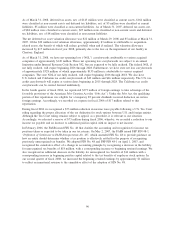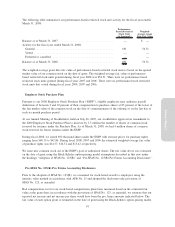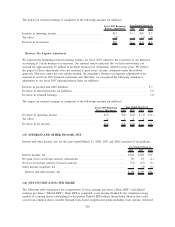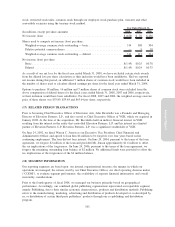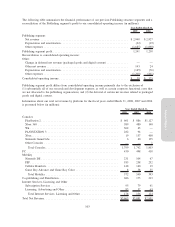Electronic Arts 2008 Annual Report Download - page 169
Download and view the complete annual report
Please find page 169 of the 2008 Electronic Arts annual report below. You can navigate through the pages in the report by either clicking on the pages listed below, or by using the keyword search tool below to find specific information within the annual report.
Prior to our adoption of SFAS No. 123(R), we valued our stock options based on the multiple-award valuation
method and recognized the expense using the accelerated approach over the requisite service period. In
conjunction with our adoption of SFAS No. 123(R), we changed our method of recognizing our stock-based
compensation expense for post-adoption grants to the straight-line approach over the requisite service period;
however, we continue to value our stock options based on the multiple-award valuation method.
Employee stock-based compensation expense recognized during the fiscal years ended March 31, 2008 and
2007 was calculated based on awards ultimately expected to vest and has been reduced for estimated
forfeitures. In subsequent periods, if actual forfeitures differ from those estimates, an adjustment to stock-
based compensation expense will be recognized at that time.
The following table summarizes stock-based compensation expense resulting from stock options, restricted
stock, restricted stock units and our employee stock purchase plan included in our Consolidated Statements of
Operations (in millions):
2008 2007 2006
Year Ended March 31,
Cost of goods sold ................................................... $ 2 $ 2 $—
Marketingandsales .................................................. 19 17 —
General and administrative ............................................. 38 37 1
Research and development.............................................. 91 77 2
Stock-based compensation expense...................................... 150 133 3
Benefit from income taxes .............................................. (27) (26) (1)
Stock-based compensation expense, net of tax ............................. $123 $107 $ 2
As of March 31, 2008, our total unrecognized compensation cost related to stock options was $186 million
and is expected to be recognized over a weighted-average service period of 2.5 years. As of March 31, 2008,
our total unrecognized compensation cost related to restricted stock and restricted stock units was $274 million
and is expected to be recognized over a weighted-average service period of 2.4 years.
APIC Pool. We elected to adopt the alternative transition method provided in FSP FAS 123(R)-3, “Transition
Election Related to Accounting for the Tax Effects of Share-Based Payment Awards”, for calculating the tax
effects of stock-based compensation pursuant to SFAS No. 123(R), which allows for a practical exception in
calculating the additional paid-in capital pool (“APIC pool”) of excess tax benefits upon adoption that is
available to absorb tax deficiencies recognized subsequent to the adoption of SFAS No. 123(R). For employee
stock-based compensation awards that are outstanding upon adoption of SFAS No. 123(R), the alternative
transition method provides a simplified method to establish the beginning balance of the APIC pool related to
the tax effects of employee stock-based compensation. It also provides a simplified method to determine the
subsequent impact on the APIC pool and Consolidated Statements of Cash Flows for the tax effects of
employee stock-based compensation awards.
Cash Flow Impact. Prior to our adoption of SFAS No. 123(R), cash retained as a result of tax deductions
relating to stock-based compensation was presented in operating cash flows along with other tax cash flows.
SFAS No. 123(R) requires a classification change in the statement of cash flows. As a result, tax benefits
relating to excess stock-based compensation deductions, which had been included in operating cash flow
activities, are now presented as financing cash flow activities (total cash flows remain unchanged). For the
fiscal year ended March 31, 2008, we recognized $45 million of tax benefit from the exercise of stock options,
net of $6 million of deferred tax asset write-offs; of this amount, $51 million of excess tax benefit related to
stock-based compensation was reported in financing activities. For the fiscal year ended March 31, 2007, we
recognized $34 million of tax benefit from exercise of stock options reported in operating activities, net of
$2 million of deferred tax asset write-offs; of this amount, $36 million of excess tax benefit related to stock-
based compensation was reported in financing activities. For the fiscal year ended March 31, 2006, we
recognized $133 million of tax benefit from exercise of stock options reported in operating activities.
Annual Report
93




